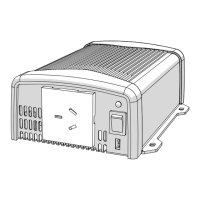13
3 INSTALLATION
Ensure that all the DC connections are tight - torque to 2.8 Nm (1.5 ft-lbs). Loose
connections could result in overheating and can be a potential hazard.
Do not operate the inverter with damaged or substandard wiring. Selecting the wrong
cable or fuse size could result in harm to the installer or user and/or damage to the
inverter or other appliances installed in the system. The installer is responsible for
ensuring that the correct cable and fuse sizes are used when installing this inverter.
Refer to section 2.2.4 for more information.
3.4 AC Safety Grounding
Depending on the user scenario, the AC output of the inverter may require a user installed
breaker or fuse. The inverter incorporates AC short circuit protection.
RCDs may be fitted by a licenced electrician in installations using these inverters. These
inverters, when installed according to the instructions in this manual, are categorised as
EPB inverters. Neither active, nor neutral is referenced to ground and/or chassis within
the inverter. An RCD will not trip when used with this inverter unless a (MEN) neutral to
earth connection is implemented before the RCD. External connection of such should be
determined as appropriate or not by the licenced electrician.
The AC output ground wire should be connected to the grounding point of the connected loads (for
example, a distribution panel ground bus). If in doubt, consult a licensed electrician.
Residual Current Devices (RCD)
Certain installation codes and/or government regulations requiring the installation of an RCD must
be done by a licensed electrician.
3.5 Maintenance
Very little maintenance is required to keep the inverter operating correctly. The exterior of the
inverter should be cleaned periodically with a damp cloth to prevent accumulation of dust and dirt.
At the same time, tighten the screws on the DC input terminals. Turn the unit OFF before cleaning.
M5 Screw
Ring Terminal
Cable

